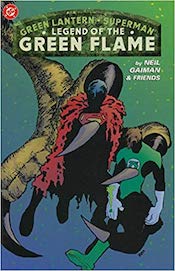Thursday Comics Hangover: The barely collected Neil Gaiman

Recently at Third Place Books, I bought a used comic. There's nothing unusual about that sentence. But the comic was written by Neil Gaiman and I'd never heard of it, which is a pretty damn rare occurrence.
Flip past the atrocious Frank Miller cover to the indicia page and you'll discover that Green Lantern/Superman: Legend of the Green Flame was originally published in 2000. Flip even further into the book and you'll learn in the introduction that DC commissioned Gaiman to write Green Flame to close out an anthology title in the year 1988.
Somehow, a Gaiman Superman comic had gone unpublished for twelve years before DC decided to pay artists to draw the book. And then the book almost immediately went out of print after it was published the first time, almost 20 years ago. Given Gaiman's global cachet, this seems like an almost criminal oversight on DC's part.
As a work of juvenilia, Green Flame is a lot of fun. It was written at the very beginning of Gaiman's career, and his dialogue evokes standard superhero fare, not his more literary Sandman comics. These are classic versions of Superman and Green Lantern: clunky, stiff, more than a little bit square.
And the plot's pretty old-school, too — mired in continuity and not necessarily new-reader friendly. Aching from a breakup, Green Lantern seeks out Superman for relationship advice, and the two investigate a mysterious artifact tied to a previous incarnation of Green Lantern. Then everything goes to Hell (literally).
As the heroes progress through the fairly straightforward plot, a few Gaimanisms make their way to the surface of the book. Superman explains that he can't look directly at a magical artifact with his X-ray vision because "it seemed infinite...as if I could look into it forever." The decision not to show the reader what Superman sees, in a media that is almost entirely devoted to image, must have required some intestinal fortitude, but Gaiman pulls it off, trusting the reader's imaginations — the real special effect in comics — to surpass anything an artist could put on the page.
But the real reason to read Green Flame is to appreciate the differences in the art styles of Gaiman's collaborators. These are stalwart superhero artists: Mike Allred, Kevin Nowlan, Eric Shanower, and more. These artists happily delivered their best work, from Nowlan's dark and creepy exploration of the Green Flame's origins to Jason Little's cheerful, cartoony resolution for the book.
Green Flame could be most charitably described as n early effort, and it is incredibly uneven, though there's real pleasure in watching the collaboration between Gaiman and his very fine artistic collaborators. And watching Gaiman take a stumble on one of his first outings is a genuine thrill. Here is a master of the form just taking his first baby steps into the world.